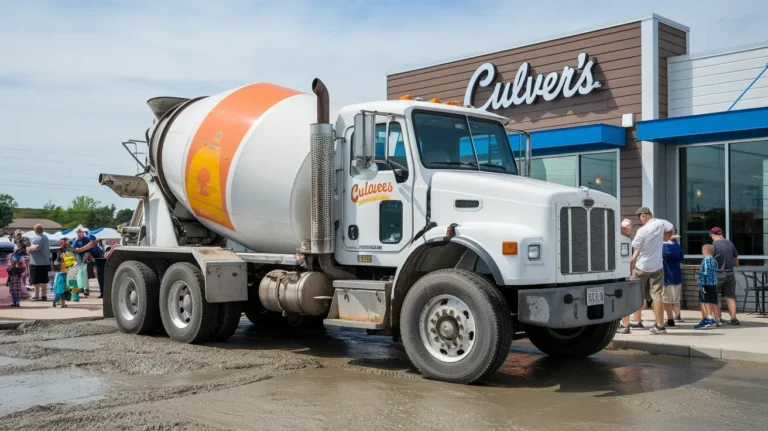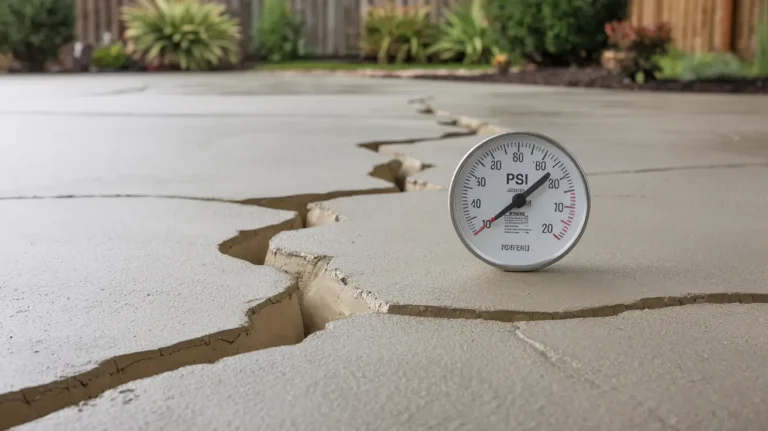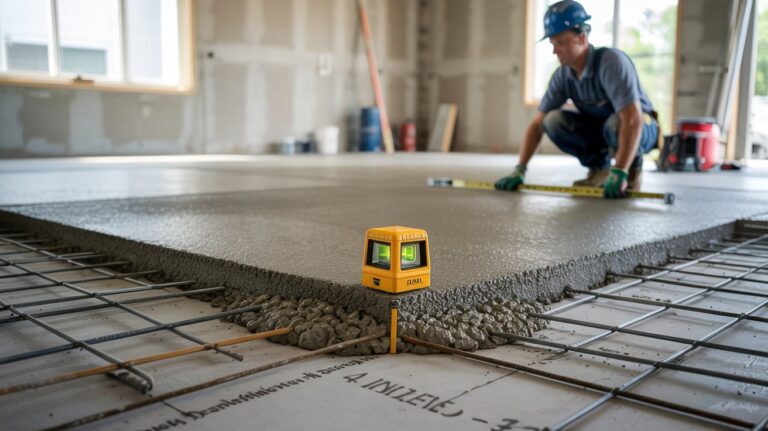How Much Concrete in a Truck

When you’re planning a concrete project, it’s vital to know how much concrete a truck can hold. A standard concrete truck typically carries between 8-10 cubic yards of concrete, ideal for larger projects.
However, smaller trucks and volumetric mixers are available for smaller projects or unknown concrete needs, holding up to 2 cubic yards. Larger trucks can carry up to 12 cubic yards, but these are less common due to road weight restrictions.
As you plan your project, understanding truck capacities and weight restrictions is key to ensuring a smooth and efficient delivery process, and exploring further will help you navigate the intricacies of concrete logistics.
Types of Concrete Trucks and Their Capacities
When you’re planning a concrete project, understanding the different types of concrete trucks and their capacities is crucial to ensuring you have the right equipment for the job.
Standard concrete trucks, also known as ready mix trucks, typically hold 8-10 cubic yards of concrete, making them ideal for larger projects.
Volumetric mixers, on the other hand, mix concrete on-site and hold raw materials in separate compartments, perfect for smaller projects or unknown concrete needs.
Smaller trucks, like portable concrete mixers or mini-mix trucks, hold up to 2 cubic yards, suitable for small projects.
Larger trucks, less common due to road weight restrictions, can carry up to 12 cubic yards of concrete, often required for large projects exceeding 10 cubic yards.
Balancing Capacity and Weight Restrictions
When you’re loading concrete into a truck, you need to ponder the weight of the concrete itself, which can be substantial – a single cubic yard weighs around 4,056 pounds.
This weight, combined with the truck’s own weight, must comply with state weight regulations, typically capped at 80,000 pounds.
As you calculate the load, you’ll need to balance the concrete’s weight with the truck’s capacity to guarantee safe transportation.
Weight of Concrete
Concrete trucks typically operate within a delicate balance between capacity and weight restrictions, and understanding the weight of concrete is crucial in achieving this balance. The weight of concrete varies depending on the type of concrete being delivered. As a general rule, a full load of concrete in a truck typically ranges from 9 to 12 cubic yards.
| Type of Truck | Weight of Concrete (lbs) | Cubic Yards |
|---|---|---|
| Standard Mixer | 40,000 – 50,000 | 9 – 10 |
| High-Capacity Mixer | 60,000 – 70,000 | 11 – 12 |
| Volumetric Mixer | 30,000 – 40,000 | 7 – 9 |
| Transfer Mixer | 50,000 – 60,000 | 10 – 11 |
When planning a concrete delivery, it is crucial to weigh the importance of the weight of the concrete so you can verify you’re not exceeding the truck’s capacity or weight restrictions.
Road Restrictions Apply
Road restrictions play a critical role in determining how much concrete a truck can carry, as they dictate the maximum weight allowed on specific routes.
You must consider these restrictions when planning your project, as they impact the truck’s capacity. A fully loaded concrete truck can weigh up to 66,000 pounds, but road weight restrictions may limit the amount of concrete you can transport.
Typically, standard trucks hold 8-10 cubic yards of concrete, which translates to 32,000-40,000 pounds. Weight considerations are essential to guarantee you don’t exceed the maximum weight limit or run out of concrete during a pour.
Factors That Affect Concrete Truck Capacity
Several key factors influence the amount of concrete a truck can carry, and understanding these variables is essential for accurate calculations and cost-effective delivery.
You need to ponder the type of concrete, as its density can vary substantially. For instance, standard concrete has a density of around 4,050 pounds per cubic yard.
Job site accessibility is another pivotal factor, as concrete trucks require sufficient room to maneuver and can weigh up to 40,000 pounds when fully loaded.
Truck design also plays a role, with rear discharge trucks able to navigate tight spaces but requiring sufficient room to turn around.
Additionally, you should be aware of short load fees and calculate the exact amount of concrete needed to avoid extra costs.
Planning a Successful Concrete Delivery
To guarantee a successful concrete delivery, you’ll need to carefully plan every detail, from ordering the right amount of concrete to coordinating with the delivery team.
This will confirm that your ready mix concrete arrives on time and in the correct quantity, which is typically measured in cubic yards.
- Verify that your construction site is ready to receive the concrete delivery, with adequate space for the concrete truck and a clear path for the delivery team.
- Confirm the concrete project’s requirements, including the type and quantity of concrete needed, to avoid ordering a full truckload that may not be necessary.
- Schedule the delivery during a time that minimizes disruptions to your construction site, guaranteeing a smooth and efficient concrete delivery process.
Keeping Your Trucks in Top Shape
Regular maintenance is crucial to guarantee your concrete trucks remain in top condition, allowing them to efficiently transport heavy loads of ready mix concrete. You need to certify your trucks can carry the weight of concrete, as it arrives at the construction site. A well-maintained ready mix truck can substantially reduce load fees and delivery fees. To keep your trucks in top shape, focus on the following key areas:
| Maintenance Area | Frequency | Task |
|---|---|---|
| Engine Oil | Every 500 miles | Check and change oil |
| Tire Pressure | Daily | Check and adjust pressure |
| Drum Rotation | Every 100 deliveries | Inspect and clean drum |
| Brake Pads | Every 3 months | Inspect and replace worn pads |
Understanding Concrete Truck Capacity and Quantity
As you guarantee your concrete trucks remain in top condition, you’ll also want to understand their capacity and quantity limitations.
A standard concrete truck can hold 8-10 cubic yards of ready-mixed concrete, but some trucks can carry up to 12 cubic yards, depending on weight restrictions.
The weight of concrete, approximately 4,056 pounds per cubic yard, affects truck capacity and road weight restrictions.
- The type of concrete mix used affects the capacity, as some mixes are denser or require more water.
- Job site accessibility can limit the amount of concrete that can be delivered.
Understanding these factors is vital for safe and legal transportation of concrete, ensuring you’re adhering to state weight regulations and maximizing your truck’s capacity.
Calculating Concrete Quantity and Costs
You’ll need to calculate the amount of concrete required for your project to guarantee you order the right quantity and avoid unnecessary costs.
To do this, use the formula: Length × Width × Depth ÷ 27 = Cubic Yards, and consider factors like project size and wastage to add 10% extra to your total.
Accurate calculations will also help you estimate truck capacity and costs, which depend on the type of concrete mix, delivery distance, and other variables.
Concrete Quantity Formula
To accurately estimate the amount of ready-mixed concrete required for your project, it’s vital to understand the concrete quantity formula.
This formula helps you determine how many cubic yards of concrete you’ll need. The formula is simple: Length × Width × Depth ÷ 27 = Cubic Yards.
- Factors such as slab thickness, project type, and wastage allowance can affect the concrete quantity needed.
- Using a concrete calculator or consulting with a professional can confirm accurate calculations.
- Correctly calculating concrete delivery costs can save you money on delivery costs and confirm you have enough concrete for your project.
Project Size and Wastage
When estimating concrete quantity, project size plays a significant role in determining the amount of ready-mixed concrete you’ll need. Larger projects require more concrete, while smaller ones need less. To get an accurate estimate, consider the project size, type of concrete, and wastage allowance.
| Project Size | Cubic Yards | Wastage Allowance |
|---|---|---|
| Small | 5-7 | 5-10% |
| Medium | 10-15 | 10-15% |
| Large | 20-25 | 15-20% |
Truck Capacity and Costs
Now that you’ve accounted for project size and wastage, it’s time to ponder the logistics of concrete delivery.
A standard concrete truck can hold 8-10 cubic yards of ready-mixed concrete, with some trucks carrying up to 12 cubic yards.
However, weight restrictions come into play, as a fully loaded truck can weigh up to 66,000 pounds.
- The weight of concrete, approximately 4,056 pounds per cubic yard, affects truck capacity and road weight restrictions.
- Calculating the weight of the concrete and the truck’s capacity is vital for safe transportation, as trucks must comply with state weight regulations.
- The cost of a truckload of concrete depends on the project, its size, and distance from the delivery company, with the national average price being $108 per cubic yard.
Concrete Delivery and Truckloads
A critical component of any concrete project is the delivery and logistics of the concrete itself.
When planning your project, you’ll need to weigh the size of the project, truck capacity, and distance from the concrete plant to determine how many truckloads you’ll need. A standard concrete truck can hold 8-10 cubic yards of ready-mixed concrete, with some trucks carrying up to 12 cubic yards.
Larger projects may require multiple truckloads, arriving at different times, and timing is vital to avoid trucks waiting, as concrete has a limited waiting period. Accurate planning helps avoid running out of concrete during a pour, and examining weight restrictions is essential for project planning.
Concrete Measurement Conversions
You’ll need to make accurate concrete calculations to guarantee you have enough material for your project.
To do this, verifying concrete conversions is crucial, such as knowing that one cubic yard of concrete is equal to 27 cubic feet.
Concrete Calculations
When working with concrete, accurate calculations are crucial to guarantee you have enough material for your project.
To calculate the amount of concrete you need, you’ll need to ponder factors such as project size, type of concrete, and wastage allowance.
- Measure the length, width, and depth of the area in feet to calculate the total cubic feet needed.
- Convert cubic feet to cubic yards by dividing the total cubic feet by 27, which helps in accurately calculating the amount of concrete required for a project.
- Remember that a standard concrete truck can hold 8-10 cubic yards of ready-mixed concrete, so you’ll want to calculate your needs accordingly to avoid short loads and additional fees.
Concrete Conversions
Converting between concrete measurements is a crucial step in ensuring accurate calculations for your project.
When working with concrete, you’ll often need to convert between cubic yards and cubic feet. To do this, remember that 1 cubic yard of concrete is equal to 27 cubic feet.
So, if you need to convert a measurement from cubic feet to cubic yards, simply divide the total cubic feet by 27. This conversion is essential when ordering concrete, as you’ll typically need to order by the cubic yard.
If you’re working on a smaller project, you may only need to purchase multiple 80-pound bags of concrete, which can be bought from a local home improvement store.
Pouring Tips and General Information
Before pouring concrete, it’s crucial to prepare the site and guarantee a smooth flow of operations.
You should confirm the site is clear of debris, and the subgrade is level and compacted.
- Verify the concrete truck’s capacity in cubic yards to confirm it can handle the amount needed for your project.
- Have a plan in place for disposing of any excess concrete and washout materials.
- Make sure the site is ready for the concrete mixer trucks to arrive, with a clear path for them to drive in and out.
Frequently Asked Questions
How Much Concrete Is in a Full Truck?
You’re wondering how much concrete is in a full truck. The answer depends on the truck size, as the concrete capacity varies from 6-12 cubic yards, with delivery limits set by batch quantity, load volume, weight restrictions, and the cement mixer’s design.
How Much Concrete Do I Need for a 24X24 Slab?
You need to calculate the concrete quantity for your 24×24 slab, considering slab thickness, mixing calculations, and coverage area. For a 4-inch thickness, you’ll require approximately 16.04 cubic yards, which translates to a specific volume conversion for pouring strategy.
Is It Cheaper to Mix Your Own Concrete or Have It Delivered?
Like a puzzle, you’re trying to fit the right pieces together for your concrete project. Comparing costs, you’ll find mixing your own can be cheaper for small projects, but DIY mistakes and labor costs might outweigh the savings, while delivered concrete offers bulk discounts and quality control.
How Much Does a Yard of Concrete Cover at 4 Inches Thick?
You’ll find that a yard of concrete covers approximately 81 square feet at 4 inches thick, considering the concrete thickness and slab dimensions, but remember that coverage area can vary depending on concrete density, pouring technique, surface preparation, and finishing methods.
Conclusion
As you navigate the complex world of concrete delivery, remember that precision is key. Just like a master chef balances flavors, you must balance capacity and weight restrictions to avoid costly mistakes.
A single miscalculation can be the difference between a successful pour and a concrete catastrophe. For instance, a 10-yard truck may seem like a safe bet, but forgetting to account for the 1-yard “stick” can leave you shortchanged.Measure twice, pour once – the recipe for a perfect concrete delivery.






